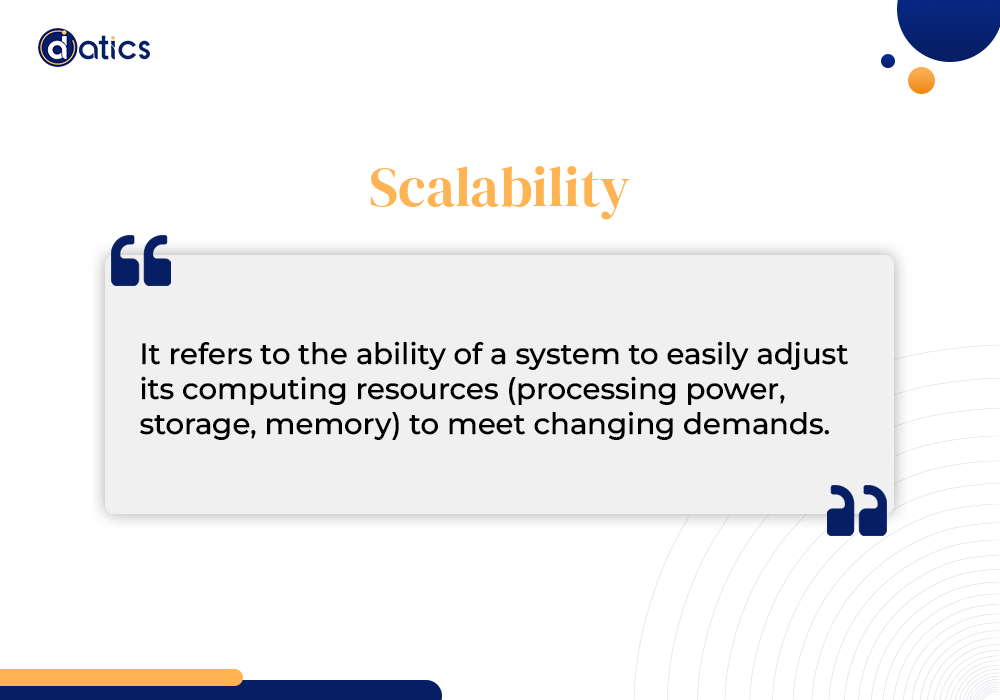Discover How Cloud-Based Development is Shaping Innovations

DaticsAI
Passionate about marketing with an affinity to learn about the ever-developing IT sector.

Table of Contents
Introduction to Cloud-Based Development
Cloud-Based Development is like a secret power for building cool apps and services without being tied down by old-school tech hassles. Think of it as making a high-tech Lego castle in the sky where you don’t worry about buying the Legos or finding a place to put them. This tech magic lets developers use online resources to create, test, and deploy their projects faster and cheaper than ever before. No more nightmares about servers crashing in the middle of the night. With cloud computing, if you need more power, it’s like asking the cloud to grow a bit larger. It’s flexible, scalable, and cost-effective. Essentially, you’re renting a supercomputer that exists somewhere out in the vastness of the internet. This means you can focus on making your app or website awesome without sweating the small stuff.
The Rise of Cloud Computing in Software Development
Cloud computing is changing how we build and use software, and it’s a big deal. Think of the cloud as a massive, virtual locker where you can store all sorts of things like data, applications, and even entire computing platforms. Developers love this because it means they can work on their projects from anywhere, without needing a super powerful computer. It’s like having a beefy, top-tier computer on demand, without actually owning one.

Now, why is cloud computing taking over? First off, it’s scalable. This means if your app suddenly becomes the next big thing, you can easily handle more users without crashing. Second, it cuts costs. No need to shell out big bucks for hardware or worry about maintenance. It’s all taken care of by the cloud service provider. Third, collaboration has never been easier. Teams can work on the same project from different corners of the world, in real time.
From startups to giants, everyone’s jumping on the cloud bandwagon. It’s not just a trend; it’s the future. And as technology grows, cloud computing is only going to get bigger and more essential. Whether we’re talking about creating new apps, analyzing big data, or anything in between, the cloud is at the heart of it all, pushing the boundaries of what’s possible.
Key Benefits of Adopting Cloud-Based Solutions

Adopting cloud-based solutions comes packed with benefits that can push businesses towards innovation and efficiency.
Scalability
Cloud services offer the flexibility to scale up or down based on demand. This means you won’t be stuck paying for resources you don’t need or scrambling to upgrade your infrastructure last minute.
Cost Savings
By moving to the cloud, businesses can cut down on the expenses of maintaining physical servers and hardware. You pay for what you use, helping you keep a lid on costs.
Accessibility
Cloud solutions allow you and your team to access data and applications from anywhere, anytime. This supports remote work and ensures that your team remains productive, no matter where they are located.
Disaster Recovery
With data backed up in the cloud, recovering from a system failure is much quicker. You reduce the risk of data loss in disasters, which is a lifesaver for any business.
Enhanced Security
Providers invest heavily in security measures to protect data, leaving you with one less thing to worry about. By leveraging cloud technology, companies can not only improve their operational efficiency but also fortify their defense against cybersecurity threats. In essence, tapping into cloud-based solutions is like hitting the fast-forward button on growth and future-proofing your business.
How Cloud-Based Development Drives Innovation
Cloud-based development is like a turbo boost for innovation. It lets teams work together and share ideas from anywhere, which means new products can be dreamed up and delivered faster than ever. With cloud services, you don’t have to spend big bucks on fancy computers or software; you can access powerful tools online for a fraction of the cost. This levels the playing field, allowing small startups to compete with the big guys. Plus, the cloud is super flexible, so you can scale up or down based on what your project needs at any time. This agility means you can experiment and iterate on your ideas without breaking the bank or wasting time. In essence, cloud-based development isn’t just changing the game; it’s creating a whole new playground for innovators to explore.
The Impact of Cloud-Based Development on Different Industries

Cloud-based development is revolutionizing industries, turning how we work, create, and deliver on its head. Let’s drill down into this impact.
Tech Industry
Tech industry is the frontline, leveraging cloud power to whip up software solutions at breakneck speeds. This is about agility. Need to push out an app fast? Cloud’s got you.
Healthcare
Picture this: doctors accessing your medical history from anywhere, making life-saving decisions with data at their fingertips. That’s cloud magic working to save lives.
Finance
Banks and fintech are now pals with the cloud, harnessing its might to crunch big data and offering services that blow your mind. Imagine checking your spending habits and getting tailored financial advice, all in real-time.
Manufacturing
In manufacturing these folks are using the cloud to track inventory, production, and even predict market trends. It’s all about staying steps ahead.
Education
Classrooms have left the four walls, thanks to the cloud. Learning is now limitless, boundless. From a kid in a remote village to a university student in a bustling city, everyone’s getting a piece of the knowledge pie.
In essence, cloud-based development isn’t just an IT thing—it’s a game-changer for just about every industry you can think of. The power of cloud computing has enabled a level of innovation, efficiency, and scalability that was previously unimaginable, and we’re just scratching the surface.
Integrating Cloud Technologies into Traditional Development Processes
Integrating cloud technologies into traditional development processes is simpler than it sounds. It’s like adding an extra gear to a bike—it makes going uphill a lot easier.
Cloud Service
Think of this like choosing the best parts for your bike. You want parts that make your ride smoother and faster. That’s what cloud services do for development—they speed things up and add flexibility.
Train Your Team
Just like you wouldn’t ride a bike without knowing how, don’t jump into cloud development without getting your team up to speed. This might involve some workshops or online courses, but it’s worth it. Your team needs to know how to ride this new bike.
Start Integration
This is where you begin to merge cloud technologies with your existing processes. It’s a bit like adding new routes to your bike ride. You start small, maybe with storage or computing power from the cloud, and then you add more as you get comfortable.
Secutity
Remember, while doing all this, keep your focus on security.
Just like wearing a helmet on a bike ride, ensuring your data is safe in the cloud is crucial. Encrypt your data, use secure connections, and make sure you’re complying with any regulations relevant to your industry.
Monitor & Adjust Your Approach
Not every road is perfect for every bike, and not every cloud solution will fit seamlessly into your processes. Be prepared to tweak things as you learn what works best for your team and your projects.
By following these steps, integrating cloud technologies into traditional development processes can enhance efficiency, improve flexibility, and pave the way for innovation. Just remember, it’s about finding the right balance for your team and your projects, and sometimes, you might need to adjust your gears along the way.
Challenges and Solutions in Cloud-Based Development

Cloud-based development packs a punch in innovation, but it’s not without its hiccups.
Challenge: Security
With data floating in the cloud, there’s always a risk of unauthorized access.
Solution: Encryption and robust access controls. This means making sure data is scrambled so only those with the right keys can read it, and tightly controlling who can access what.
Challenge: Disaster Recovery
Cloud services can sometimes go offline, halting development work.
Solution: Redundancy. This involves having backups of your cloud services so if one goes down, another can take over.
Challenge: Cost Savings
It’s easy for expenses to spiral if you’re not careful.
Solution: Staying on top of monitoring and budgeting. This means keeping a close eye on your cloud usage and costs, adjusting as needed to avoid surprises.
Challenge: Scalability
Navigating data privacy regulations can be tricky since laws vary by region.
Solution: Here lies in staying informed and compliant. This involves understanding the laws that apply to your data and ensuring your cloud usage aligns with these regulations.
Tackling these challenges head-on with smart solutions ensures cloud-based development remains a powerful tool for innovation.
Case Studies: Success Stories in Cloud-Based Projects
Big names like Netflix, Airbnb, and Spotify have nailed it by betting big on cloud-based development. Let’s break it down.
Netflix
Once a DVD rental service, shifted entirely to the cloud.
The result? Smooth streaming for millions, anywhere, anytime.
Their secret? Using cloud power to handle massive traffic and store colossal amounts of data.
Airbnb
They used the cloud to scale up fast. From a small website to a global platform, the cloud supported their growth, handling bookings and listings without a hitch.
Sportify
They went all-in on the cloud to manage their ginormous music library and user base. This move made music streaming seamless, with personalized playlists and recommendations on the fly.
Each story shows how cloud-based development isn’t just tech talk; it’s a game-changer for businesses aiming sky-high.
The Future Outlook of Cloud-Based Development and Emerging Trends
Cloud-based development isn’t just a buzzword; it’s the future. Companies big and small are jumping onto the cloud bandwagon, and it’s not hard to see why. The flexibility, scalability, and efficiency cloud computing offers are unmatched. But what does the future hold? Expect more innovation. AI and machine learning are getting cozy with cloud technologies, making smart applications smarter and more accessible. Then there’s the Internet of Things (IoT), where everyday devices connect and communicate, thanks to the cloud’s power.
We’re also seeing a push towards green computing. The cloud is becoming more energy-efficient, reducing the carbon footprint of digital operations. And let’s not forget about edge computing – processing data closer to where it’s created for faster insights. It’s an exciting time, with cloud-based development leading the charge towards a more innovative, efficient, and sustainable future. Stay tuned; the ride’s just getting started.
Conclusion and Next Steps for Businesses Embracing Cloud-Based Development
As we draw this discussion to a close, it’s crystal clear that cloud-based development is not just a fleeting trend—it’s the bedrock of future innovations. For businesses ready to embrace this shift, the next steps involve rigorous planning and action.
First, assess your current technological infrastructure and determine what needs to evolve.
Second, invest in training your team or hiring talents proficient in cloud technologies. Integrating cloud solutions into your operations can streamline workflows, boost efficiency, and unlock new opportunities for growth. The journey doesn’t stop at adoption; it’s about continuous improvement and staying ahead of the curve.
Remember, the transition to cloud-based development is an investment in your company’s agility and competitiveness in the digital era. Start small, think big, and scale fast.
